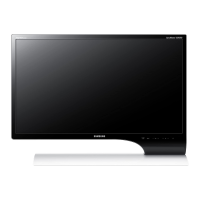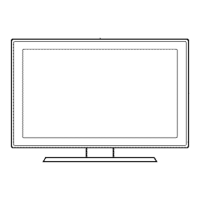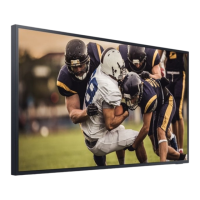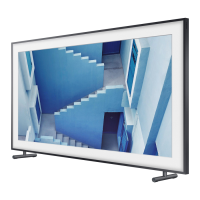Do you have a question about the Samsung LED 6500 series and is the answer not in the manual?
Describes methods to scroll through pages in the e-Manual.
Explains the use of back, forward, and opened pages icons.
Details how to navigate back to the e-Manual's home page.
Instructions for using the index to find specific terms within the e-Manual.
Guide on how to search for specific content within the e-Manual.
Instructions on how to exit the e-Manual.
How to directly navigate to specific menu items within the e-Manual.
Steps to update the embedded e-Manual to the latest version.
Guide on connecting the aerial cable to the TV's input connector.
Instructions for connecting video devices using an HDMI cable.
Steps for connecting video devices using Component cables.
Guide on connecting AV devices to the TV for video input.
How to connect audio devices using an optical cable.
Connecting audio devices to the TV's audio output.
Using HDMI for digital sound output from TV to AV receiver.
Connecting a computer to the TV via HDMI.
Connecting a computer using an HDMI-to-DVI cable.
How to switch between different connected video sources.
Options like Edit Name, Refresh, and Disconnect USB.
Setting up the TV to control other devices.
Automatically scans and indexes available TV channels.
Configuring TV channels, including tuning and area settings.
Importing or exporting the TV's channel map via USB.
Removing channels, sorting, editing favourites, and checking info.
Removing unwanted channels from the TV's index.
Changing the channel number in the edit channels list.
Blocking programmes based on their rating.
Locking specific channels to prevent viewing and unlocking them.
Changing the names of analogue channels.
Adding channels to a favourites list for easy access.
Removing channels from a favourites list.
Changing the order of channels in a favourites list.
Renaming an existing favourites channel list.
Steps for setting up a wired network connection.
Troubleshooting common issues with wired network connections.
Connecting the TV to the internet using a wireless network.
Connecting to a wireless network using the WPS button.
Troubleshooting common issues with wireless network connections.
Viewing the current network and internet connection status.
Connecting mobile devices to the TV wirelessly without a router.
Configuring settings for playing media from networked devices.
Assigning a custom name to the TV for network identification.
Guide on how to insert batteries into the Smart Touch Control.
Pairing the Smart Touch Control with the TV via Bluetooth.
Explains the functions of various buttons on the remote.
Details touchpad gestures like drag, press, flick, and scroll.
Accessing viewing history and performing searches using the remote.
Selecting which panel to display on the virtual remote.
Adjusting the position of the virtual remote panel.
Entering numbers via the virtual remote's number panel.
Controlling media playback using the virtual remote.
Quickly accessing common buttons on the virtual remote.
Resizing the virtual remote control window.
Connecting the IR Extender Cable for remote control setup.
Setting up the TV to control external devices.
Managing configured external devices (setup, power, rename, delete).
Entering text using the TV's virtual keyboard.
Using an external QWERTY keyboard for text input.
Language, Recommend Text, and Predict Next Letter options.
Important notes regarding SMART Interaction features.
Overview of face recognition for logging into Smart Hub.
Guidelines for using the TV camera for features like motion and voice control.
Using hand gestures to control the TV via the camera.
Using voice commands to operate TV functions.
Configuring language and TV voice responses for recognition.
Examples of advanced voice commands for specific tasks.
How to turn off the voice recognition feature.
Overview of motion control features and requirements.
Conditions for optimal motion control performance.
How to activate motion control using hand gestures.
Common hand gestures for TV navigation and selection.
Adjusting animated guide, environment test, and pointer speed.
Icons and their descriptions during motion control operation.
How to make motion control icons reappear on the screen.
Optimal conditions for face recognition to work correctly.
Steps for registering a user's face for login.
How to log into Smart Hub using face recognition.
Connecting USB or Bluetooth keyboards for text entry.
Explains keyboard keys for TV control.
Connecting USB or Bluetooth mice for navigation.
Describes mouse button functions for TV control.
Viewing details about the current programme.
Accessing the electronic programme guide for schedules and navigation.
Setting reminders to watch programmes at a future time.
Managing and viewing the list of available TV channels.
Recording programmes for later viewing using USB storage.
Configuring external storage for recording and Timeshift functions.
Options for recording programmes like instant or scheduled.
Playing back recorded TV programmes and managing recordings.
Pausing and resuming live TV broadcasts, and scanning through them.
Health and safety warnings related to 3D viewing.
Advice for optimizing the 3D viewing experience.
Selecting and enabling different 3D viewing modes.
Adjusting perspective, depth, and L/R swap for 3D.
Enabling PIP and configuring channel, size, position, and sound.
Adjusting analogue picture settings to reduce noise and shakiness.
Setting primary and secondary audio languages for digital channels.
Selecting the desired audio format for digital channels.
Enabling/disabling and adjusting volume for audio descriptions.
Displaying subtitles for digital and analogue broadcasts.
Setting primary and secondary subtitle languages.
Setting the language for Teletext service.
Information about the Digital Text (MHEG) function.
Selects viewing modes like Dynamic, Standard, Movie, etc.
Fine-tuning settings like Backlight, Contrast, Sharpness, Colour.
Copying current picture settings to other inputs or all sources.
Changing aspect ratios (16:9, Zoom, 4:3, Screen Fit) and position.
Optimizing settings for sports viewing experience.
Turning off the screen and resetting image settings to default.
Fine-tuning contrast, black tone, flesh tone, colour space, white balance.
Adjusting colour tone, digital clean view, MPEG noise filter.
Selecting sound modes like Standard, Music, Movie, Clear Voice.
Using sound effects like DTS TruSurround, TruDialog, and Equalizer.
Automatically adjusting volume levels for consistent sound output.
Enhancing sound for 3D video content.
Adjusting sound based on TV installation (stand or wall mount).
Restoring all sound settings to factory defaults.
Choosing audio output speakers (TV, external, or both).
Connecting Samsung audio devices via Bluetooth using SoundShare.
Configuring DTV audio level and digital audio output options.
Manually or automatically setting the TV's clock.
Adjusting time difference hourly for accurate time display.
Automatically shutting off the TV after a set period.
Setting the TV to turn on automatically at a specific time.
Setting the TV to turn off automatically at a specific time.
Adjusting brightness and preventing overheating for power saving.
Technologies and functions to prevent screen burn-in.
Steps to change the TV's password for security.
Selecting the display language for the TV menus.
Enhancing picture quality with compatible Samsung devices via HDMI.
Adjusting the transparency level of the menu screen.
Adjusting audio cues for menu navigation and selections.
Locking or unlocking the TV's front panel keys.
Enabling or disabling the TV's startup logo display.
Adjusting power frequency to stop camera flickering.
Information on playing DivX protected videos.
Core entertainment centre for web browsing, apps, and media.
Accessing YouTube, Facebook, Twitter, and video calls.
Downloading and installing applications like WebBrowser.
Viewing recommendations, setting auto-start for Smart Hub, managing adult content.
Playing media files from external storage devices.
Terms and conditions for using the Smart Hub service.
Steps to create a new Samsung account via email or Facebook.
Signing into Smart Hub using Samsung account credentials.
Connecting Samsung account to other services like Facebook.
Editing profile, removing accounts, and resetting Smart Hub.
Finding apps, content, and web information on the TV.
Displaying the status and notification banner on screen.
Configuring SMART Interaction features via banner.
Managing Samsung account via the status banner.
Configuring network settings via the status banner.
Viewing and managing system notifications and messages.
Watching YouTube, Facebook, Twitter, and making video calls.
Configuring social features and connecting to services.
Selecting and playing videos from social feeds.
Viewing friend profiles and initiating video calls.
Applying filters to sort content in social feeds.
Collection of free and paid apps for download and use.
Limitations and conditions for using Samsung Apps and Smart Hub.
Automatic installation of basic apps upon network connection.
Opening installed applications from the Apps screen.
Searching for and installing applications from the Samsung Apps store.
Changing order, removing, and adding apps to My Apps.
Removing installed applications and their data.
Creating and organizing apps into folders.
Locking or unlocking applications for security.
Updating installed applications to the latest version.
Application for staying fit, creating exercise plans, and tracking progress.
Launcher for child-friendly applications and content.
Browsing the internet on the TV using a web browser application.
Accessing and using social networking services on the TV.
Service for enjoying 3D content like movies and documentaries.
Displaying real-time updates like stock values and news.
Enabling/disabling and viewing push notifications from apps.
Using apps linked to current TV channel data services.
Viewing app version, TV serial number, and memory capacity.
Viewing programme guide and information easily.
Setting broadcast media type and TV stations for the On TV screen.
Receiving notifications for popular TV programmes currently airing.
Determining programme display preference (user or popularity).
Hiding adult TV programmes from the On TV screen.
Configuring Smart Hub to launch automatically on TV startup.
Selecting and viewing recommended programmes.
Viewing info and accessing options for upcoming recommended programmes.
Notes on supported USB devices, file systems, and power requirements.
List of compatible photo, music, video, and subtitle file types.
Connecting and playing media files from USB devices.
Safely removing USB devices from the TV.
Accessing all media files regardless of type.
Launching the Recorded TV feature.
Clearing the history of recently played media files.
Displaying media from web storage, computers, and DLNA devices.
Selecting devices to connect to the TV over a network.
Retrieving and enjoying media files from DLNA devices.
Sending files to different storage devices.
Sorting video files by category.
Creating playlists of selected video files.
Navigating and playing specific video files.
Scanning through video files in increments or by scene.
Displaying subtitles for video files if available.
Adjusting repeat, size, rotate, receiver, picture, sound, language, info.
Sorting music files by category.
Creating playlists of selected music files.
Scanning through music files or pausing playback.
Navigating and playing specific music files.
Adjusting repeat, shuffle, receiver, sound mode, and information.
Sorting photo files by category.
Viewing photos as a slideshow with various settings.
Adjusting slideshow speed and effects.
Creating playlists of selected photo files.
Navigating and viewing specific photo files.
Enabling background music for slideshows.
Controlling background music during slideshows.
Adjusting zoom, rotate, size, receiver, picture, sound, info.
Important notes regarding Anynet+ compatibility and usage.
Enabling/disabling Anynet+ and auto turn-off features.
Operating connected external devices using the TV remote.
Selecting and switching between connected Anynet+ devices.
Accessing menus and tools of connected external devices.
Using HDMI ARC for digital audio output to AV receivers.
Displaying mobile device screens wirelessly on the TV.
Allowing Samsung technicians to diagnose and repair the TV remotely.
Accessing the built-in electronic user manual for TV features.
Diagnosing picture, sound, and signal issues using built-in tools.
Checking for and installing TV software updates.
Selecting TV usage mode (Home Use vs. Store Demo).
Information on product support and obtaining the latest software.
Navigating and using Teletext pages for information.
Supported resolutions for connecting computers to specific TV models.
Supported resolutions for connecting computers to LED 4500 series TVs.
Resolutions supported for 3D content via HDMI connection.
Resolutions supported for 3D content via Component connection.
Resolutions supported for 3D content from digital channels.
List of supported external and internal subtitle file names and containers.
List of image file types and their corresponding resolutions.
List of music file types, codecs, and comments.
Details on supported video codecs, containers, resolutions, and bit rates.
Limitations on codecs, video/audio playback due to content or signal.
Supported video codecs and their limitations.
Supported audio codecs and their limitations.
Important cautions for adults and children using the 3D function.
Instructions for safe placement, handling, battery use, and cleaning.
Steps to follow when requesting warranty service or repair.
Terms and exclusions that apply to the product warranty.
Information about DivX certification and video format.
Information regarding DTS and Dolby audio technologies licences.
Information about HDMI interface and logo trademarks.
Availability of open source licences on the product menu.
Solutions for flickering or dimming screen issues.
Troubleshooting colour problems and connector issues.
Adjusting brightness and fixing blurriness or ghosting.
Solutions for unwanted powering off or problems powering on the TV.
Troubleshooting problems with finding or tuning channels.
Addressing distorted pictures, colour problems, and black/white display.
Solutions for dotted lines on screen edges or incorrect aspect ratios.
Troubleshooting picture freezes or delays when changing channels.
Solutions for issues with no sound or low volume at maximum.
Troubleshooting sound issues when the picture is fine.
Addressing odd sounds from speakers or audio cable problems.
Common issues with 3D active glasses and image quality.
Solutions for issues with channel reception and subtitles.
Resolving 'Mode Not Supported' messages and no audio issues.
Solutions for wireless connection failures and software update errors.
Addressing issues related to the TV getting hot during operation.
Solutions for pictures not displaying in full screen or 'Mode Not Supported'.
Fixing grayed-out subtitle menus, plastic smell, and tilted TV.
Troubleshooting when the Broadcasting menu is unavailable.
Solutions for lost settings and intermittent audio/video loss.
Addressing bezel particles and PIP menu unavailability.
Explaining normal noises and troubleshooting humming sounds.
Preventing and addressing image retention on PDP TVs.
Resolving problems with USB device recognition, formatting, and performance tests.
Troubleshooting issues with schedule recording and Timeshift operations.
Solutions when Anynet+ devices are not recognized or controlled.
Troubleshooting exiting Anynet+, messages, and device display problems.
Resolving issues with TV audio not playing through the receiver.
Troubleshooting problems with playing back media files.
Resolving issues with application content language and service functionality.
Notes on compatibility, file downloads, website access, and ActiveX.
Troubleshooting delays, corruption, font display, and bookmark limits.











